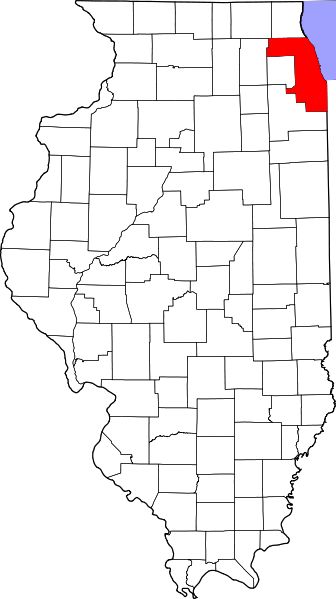Refine Who You Are Looking For
Cook County White Pages
Cook County, located in Illinois, is the second most populated county in the United States after Los Angeles County in California, with an estimated population around 5.2 million people. Cook County incorporates the city of Chicago, which is not only the largest city in Illinois, but also the third most populated city in the United States, with 2.7 million people. This doesn’t include Chicago Heights, which is a suburb south of Chicago and has a population of 29,571. More than 40% of all residents of Illinois live in Cook County.
Addresses is constantly updating their information with new public records. Search on Addresses.com to find more information about Cook County property records, criminal reports, and contact information on someone you know.
View Property RecordsCook County Population
Cook County is the most populated county in Illinois, followed by DuPage County, although the latter only has 916,924, a difference of around 4.2 million people. The county borders Lake County, Kane County, Lake County in Indiana, McHenry County, Porter County in Indiana, Berrien County in Michigan, DuPage County, and Will County.
If you’re looking for someone and only have a name and their general whereabouts, you can narrow your search by considering the demographic of the people in Cook County.
As of 2017, the median age of residents in Cook County was 36.8, but it’s slightly increasing, as 2016 showed a median age of 37. The median age of those born in the United States who are living within the county is 33 years of age, which is much younger than the median age of those who are foreign-born, which is 46 years old. 89.5% of those living in Cook County are United States citizens and 21.2% of residents were born outside of the country (1.11 million people). This is higher than the national average; the percentage of non-native residents living in the United States is only 13.7%. This percentage has stayed consistent, as 21.2% was also the number of foreign-born residents in Cook County in 2016.
There are 1.65 times more White Alone residents in Cook County (2.2 million people) than any other race or ethnicity. The second and third most common ethnic groups were Hispanic/Latino (1.33 million) and Black/African American Alone (1.2 million). Since the Hispanic/Latino community is the second largest group, it makes sense that Spanish is the most common non-English language spoken in Cook County (20.8%, or over 1 million of the county population, speak Spanish.) The second most common is Polish (2.81%) and third is Chinese, including Mandarin and Cantonese (1.33%). 35.6% of Cook County citizens speak a language outside of English, which is higher than the national average of 21.8%.
As of 2017, the median property value in Cook County was $247,600, which is 1.14 times larger than the national average of $217,600. This is a 5.63% increase in property value from 2016, which was $234,400. Due to cost of living, the average rate of homeownership is 56.4%, which is lower than the national average of 63.9%. Although the housing market is competitive, the median household income is increasing – in 2016, it was $60,046, and in 2017, it grew to $61,405.
The most common industries for residents in Cook County are Health Care and Social Assistance (359,078 people), Manufacturing (251,042), and Professional, Scientific and Technical Services (245,584).
Cook County Property Records
There are 135 separately incorporated municipalities partially or wholly located within Cook County, which includes Chicago. The section directly outside Chicago city limits is divided into 29 townships, of which the most populated is Thornton Township (169,326 people). As of 2010, Cook County’s land area was around 945 square miles, and it shares the state’s Lake Michigan shoreline with Lake County. Cook County is 690 square miles of water (42.2%), which mostly comes from Lake Michigan.
Cook County is also home to a network of 68,000 acres of open spaces containing forest, prairie, wetland, streams and lakes, known as Cook County Forest Preserves, all within the urban surroundings of Chicago. It also contains a zoo and botanical garden, all managed and owned by the Forest Preserve District of Cook County Governmental Commission.
On a scale of 1 to 100, Cook County is right around the national average at 35.5 for property crimes, 1 being low and 100 being high. Property crime includes theft, burglary, arson, larceny, and motor vehicle theft. It’s worth noting however that property crime means there is no physical violence against the victim, i.e. these crimes are based on the owner being absent or asleep. In regards to violent crimes, Cook County comes in below the national average at 17.9, making it safer than many other large metropolitan counties. If you have specific concerns, about someone, run a background check to find out if they have a criminal record.
Cook County Facts
Official Name: Cook County
Name Meaning: Cook County was named after Daniel Cook, who was one of the earliest and youngest statesmen in Illinois history.
Year Formed: Cook County was created out of Putnam County on January 15th, 1831.
Total Sq Miles: 1,635
Population: 5.2 million
Fast Facts:
- In the 1980’s, Cook County was ground zero to an extensive FBI investigation called “Operation Greylord”, named after the curly wigs worn by British judges. The investigation looked into corruption in the judiciary. 92 officials were indicted, including 17 judges, 48 lawyers, 8 policemen, 10 deputy sheriffs, 8 court officials, and a state legislator.
- Cook County is among few areas in the United States to border two counties with the same name (Lake County, Illinois and Lake County, Indiana).
- The Pullman National Monument (also known as the Pullman Historic District) is located in Chicago and was the first model, planned industrial community in the United States. It has its origins in the Pullman Car Company, which manufactured railroad cars. It became one of the most famous company towns in the United States.

